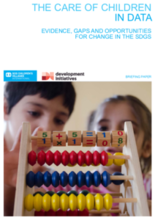Introduction
The 2030 Agenda for Sustainable Development commits all 193 Member States of the Nations (UN) to put in place policies, investments and monitoring systems that ensure all children and young people can realise their rights and full potential through equal access to a range of supportive services and opportunities for personal development.
As many as 14 out of the total 17 Sustainable Development Goals (SDGs) and up to 143 targets of the 2030 Agenda directly or indirectly relate to children’s needs and rights, ranging from ending multi-dimensional poverty and violence in all its forms, to ensuring universal access to quality education, health, social protection, employability support, birth registration and other vital services. These come with an accountability of States to develop quality, accessible, timely and reliable data to help with the measurement of progress in the implementation of this Agenda and ensure that ‘no one is left behind.'
A lesson learnt from the expired Millennium Development Goals (MDGs) is that implementation efforts are likely to bring no gains for marginalised groups if the specifc challenges that they face are not recognized and addressed - the poorest 5% made no progress at all between 1999 and 2008. Therefore, the identifcation of children in vulnerable situations and understanding of the determinants of their vulnerability through disaggregated data is critical to know who is missing on progress and prevent short fallings towards the SDGs. However, data and statistics available in national and international statistical systems are still limited or poor for over half of the child-related SDG global monitoring indicators, leaving governments without the necessary information to tackle the obstacles of vulnerable and marginalised children.
Specifically, children and young people made vulnerable by the loss of parental care or by families at risk of abuse and neglect remain virtually invisible in official statistics. While the child’s caregiving environment is the core of a child’s development, it is still largely overlooked as a factor creating vulnerability and marginalisation. When data is available, it is not fully used to inform child protection policy and services. A concerning data gap on children living outside of parental care currently restricts the ability of decision-makers and duty-bearers to know the needs of these children and take the right steps to ensure they are nurtured and empowered to participate in society.
More comprehensive data systems that count all children are crucial to ensure that they achieve positive outcomes regardless of their background and no one is left behind. The call for timely investment in the statistical capacity of countries to produce and use reliable disaggregated data under SDG 17 has been echoed by several experts and institutions, including the Independent Expert and Advisory Group on Data Revolution for Sustainable Development, the High-level Group for Partnership, Coordination and Capacity-Building for Statistics for the 2030 Agenda for Sustainable Development, the UN Statistical Commission and the UN Secretary General. The present paper explores how such call can be turned into concrete action to ensure that data for sustainable development include in the picture some of the most neglected children in the world, those who have lost or risk losing parental care.

